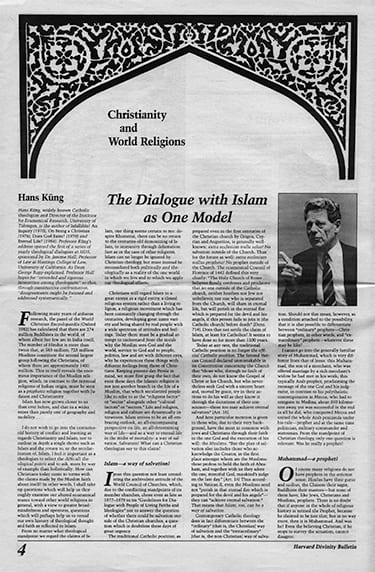A Look Back
The Dialogue with Islam as One Model
Because this issue is in most ways a debut, one of the most daunting promises we are making to our readers is to incorporate elements (both editorial and design) from past Harvard Divinity Bulletins, through fresh ideas that will maximize content and minimize gloss. So, admittedly, we headed for the archive with intellective fears: would articles from 20-plus years ago be untenable, their language and phraseology dated, even offensive? Worse, would we find the same issues being argued, apparently with-out reconcile?

Harvard Divinity Bulletin, January 1985
What we (re)discovered was a trove of challenging material, and yes, some cringe-worthy language, especially in regard to religious pluralism. For this issue, we’re highlighting a January 1985 issue with a brief excerpt from “The Dialogue with Islam as One Model,” an article by the Catholic theologian Hans Küng. The message is still urgent, hopeful, and sadly prescient:
“We are faced with a problem of extraordinary moment, the consequences of which are not yet visible. Given that the exegetical and historical findings which we have outlined here are accurate and capable of being further clarified, they constitute a challenge to both sides to stop thinking in terms of alternatives, of Jesus or Muhammad, and to think instead, despite all limitations and differences, in terms of synthesis, of Jesus and Muhammad, in the sense that Muhammad himself acts as a witness to Jesus, albeit not to a Jesus as Hellenistic Gentile Christians could have viewed him, but a Jesus as viewed by his first disciples, who were Jews like Jesus himself.”
Please follow our Commentary Guidelines when engaging in discussion on this site.

